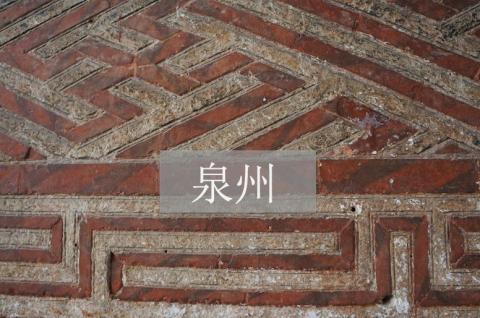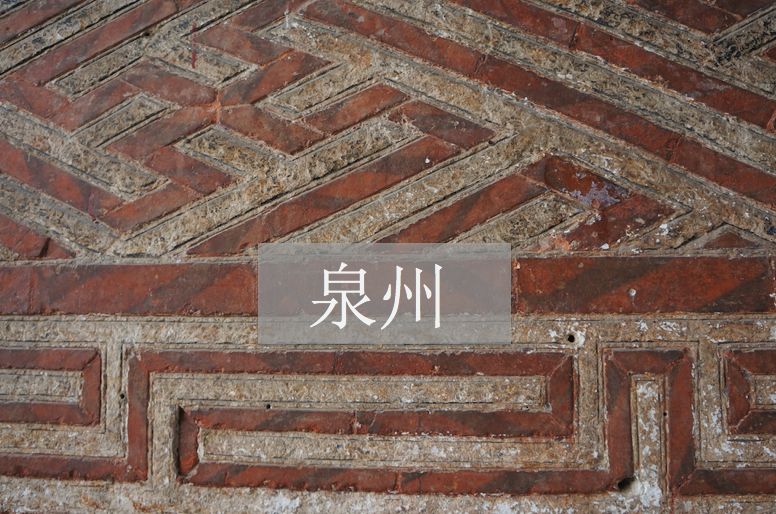

When an unknown alley disappears during "renovation", when the incense in a dilapidated small temple goes out, when an old banyan tree with a long beard is destroyed by lightning... When a pond is filled in, it may cause many "sad bridges" Under the spring waves and green, it was an unforgettable memory of "the shadow of a thundering scorpion came".
I have heard some friends praise Quanzhou, saying that the streets and alleys of the old city have a "feeling".

Quanzhou’s promotional card is a photo of streets and alleys with red roof tiles taken from above Kaiyuan Temple.
We walked to Kaiyuan Temple early in the morning. In the temple, the two towers, the East and West Towers, are exquisite . Except for the reliefs on the base of the West Tower which were added later and are a bit dull, the ancient reliefs on the two towers are worth a closer look. Among them, the reliefs on the base of the East Tower are The comic reliefs of "Two Lions Playing with a Ball" and "Two Dragons Playing with a Pearl" can make people stunned.
Walking around Kaiyuan Temple in the morning, my biggest enjoyment is the "song of birds and the fragrance of flowers". The temple looks like a park, but it is not noisy. Birds chirp occasionally and fragrance floats in the air.



Kaiyuan Temple East Tower
Kaiyuan Temple is full of incense, but there is no smell of fireworks, and it seems more casual. There are also many temples in Quanzhou. If you just walk around the old city, you can find Guanyue Temple, Confucian Temple, Qingjing Temple, Chongfu Temple, Chengtian Temple..., and Southern Shaolin. JF and I mainly looked at things related to marine culture this time, so after leaving Kaiyuan Temple, we went to Tianhou Temple on the edge of the old city.
The Tianhou Temple in Quanzhou is the earliest and largest existing one on the southeastern coast. Many Mazu temples in Taiwan and Southeast Asia are also branches here. It is said that Zheng He also came here to worship during his voyages to the West. In the late Ming and Qing Dynasties, many emperors successively honored Mazu. To this day, there are still plaques written by Yongzheng in the palace, "Shenzhao Haibiao" and "Haibang Pillar". As for the incense here, you can tell by looking at Mazu's "face". She was not born with a "dark face".


Quanzhou Tianhou Palace
The back hall of Tianhou Temple is the Mazu Cultural Museum contracted by a certain company. It seemed that it had just been renovated, and the smell of chemicals was pungent and harsh. It was a large room with dim lighting and few exhibits. Most of the exhibition materials were the same old group photos of cultural exchange leaders. It's a pity that such a wonderful Mazu culture and such a large-scale Tianhou Temple do not have good museum talents or institutions to build it. Including many Mazu temples along the southeast coast, due to uncreative and even sloppy management, people feel that they have strayed into a place of deception, abduction, fortune-telling and superstition. The "Maritime Silk Road" has been talked about for a long time. It is better to go to Japan and South Korea to learn from their museum construction and actually do something.
After leaving Thean Hou Temple, we took a taxi to the Overseas Chinese History Museum. It was undergoing renovation, so I had to go to the next stop, the Overseas Transportation History Museum.

Overseas Transportation History Museum
The Overseas Transportation History Museum is located next to the Citon Hotel in a quiet environment. A two-story building with four exhibition halls, the exhibits are very rich. It was almost noon when we arrived. A group of primary school students had just come out from the tour under the leadership of their teacher. After that, there were only two tourists: me and JF. One downstairs is a temporary exhibition hall, "Quanzhou - 'Maritime Silk Road' Photo Exhibition"; the other is the Quanzhou Stone Carvings Hall. The exhibits in the hall are jaw-dropping, with themes from Hinduism, Christianity, Islam, and Buddhism. Even the integration on a stone carving confirms that the religious culture in Quanzhou's history is rich, colorful and inclusive. It was also here that we saw the Bodhisattva with angel wings riding on auspicious clouds and holding a cross, learned about the story of the Indian temple pillars in Kaiyuan Temple, and saw the legendary Mani statue. The two exhibition halls upstairs are all about ship transportation. Each ship model displays the history of the development of ancient shipbuilding technology, as well as the helplessness and adventurous spirit of coastal residents who set sail to sea.

Quanzhou Prefecture Confucian Temple
We had lunch near Fuwen Temple and fell asleep. It's already sweltering on days when it's not raining. Downstairs is a teahouse that listens to the Nanyin of Quanzhou. It was not open yesterday evening. I checked today and it is still not open. It seems that I can't hear it this time. I mentioned to my senior sister Wang Xinxin, a Nanyin artist whose ancestral home is in Quanzhou, and she also knew about it. She said that Wang Xinxin was very beautiful, like the person in the painting, and the scenes during the performance were also as beautiful as in poetry. However, Nanyin in Quanzhou is still relatively common. After dinner, the elderly move a chair to sit under the stage, and the eldest sister and sister-in-law on the stage play the piano and sing.
After feeling sleepy after eating, I decided to continue walking. The time spent in Quanzhou is too short, so it’s better to see more. I walked into the Fu Confucian Temple and saw a father licking his head and kowtowing to three or four children in front of the statue of Saint Kong. Among them was a little boy who looked like he had just learned to walk. They all knelt down and worshiped, seemingly understanding. . I watched from the side and couldn't help but laugh. I thought they were really cute. The father saw me smiling and smiled himself.
The Confucian Temple is the pride of Quanzhou people. Several people said proudly: " The branch venue of the 2016 Spring Festival Gala is our Confucian Temple here!" I was having lunch in a restaurant just now, and there was a table in front of me that looked at Quanzhou people. The couple enthusiastically introduced Quanzhou to a pair of tourists from Shenzhen at the table next to us and said the same thing.



After coming out of Fuwen Temple, we started walking through the alleys. Goldfish Alley, Tongzheng Alley, Yuxi Alley, Pei Alley, Jiyiguan Alley, Gurong Alley, Sanchao Alley, Xiangfeng Alley , stopped and walked, and turned to the entrance of Kaiyuan Temple on West Street. It didn't seem to be far away. I kept walking and stopped. I saw the Dong Yang Ancestral Hall on the way and also accidentally walked into the Quanzhou Puppet Troupe which was rehearsing. Most of the houses on both sides of the alley are no longer habitable, and some narrow alleys still exude the smell of corruption.


Quanzhou once had a glorious history as "the first port in the East" and a prosperous city as "businessmen from all over the world amidst the sound of rising seas". However, like many old cities in China, there are many ancient ruins scattered in every corner, waiting for people to painstakingly discover them.
Quanzhou is also undergoing transformation. Quanzhou Port and the two major commercial towns of Jinjiang and Shishi are creating the prosperity of the new Quanzhou. The news that tens of millions of married women are conveying the pride of Fujian merchants in Quanzhou. And these, when you only walk around the old city, you will feel very far away, as if they are the story of Taizhou, Wenzhou or Chaoshan.
"Big Quanzhou" is being renovated, but tourists are strolling through the old Quanzhou, either praising or feeling sorry. Old Quanzhou, the "Red City" with red walls and red tiles, has become very embarrassing in the rapid development of Quanzhou. The old ones were torn to pieces, suddenly stopped, the limelight turned, and then repaired. I didn’t know how to repair it, so after repairing it, I decided it wasn’t possible, the money wasn’t enough, and it was too difficult, so I just left it alone. When people who once lived in the old city accepted this familiar face, they also felt strange and nostalgic.


Cities are the carrier of people's lives. It records history and carries culture, including the burning pain of war, economic glory, the joys and sorrows of a family and even a generation, and endless stories and information. Since the Tang and Song Dynasties, Quanzhou has had a tradition of sailing on Tishan Mountains. With the seasonal monsoon, Quanzhou people’s footprints have spread almost all over the world. Taiwan was recovered and developed by Zheng Chenggong, a native of Nan'an, Quanzhou. After entering the Qing Dynasty, it was initially under the jurisdiction of Quanzhou Prefecture. Today, nine million Taiwanese compatriots have their ancestral home in Quanzhou. The tombs of our ancestors are located here, and the information about their ancestral land has touched their hearts for generations. When an unknown alley disappears during "renovation", when the incense in a dilapidated small temple goes out, when an old banyan tree with a long beard is destroyed by lightning... When a pond is filled in, it may cause many "sad bridges" Under the spring waves and green, it was an unforgettable memory of "the shadow of a thundering scorpion came".
